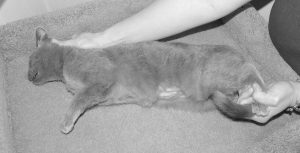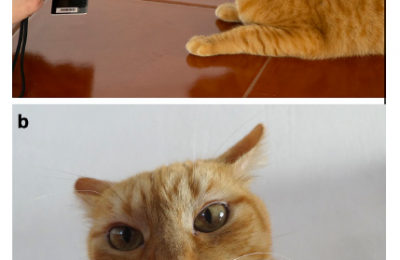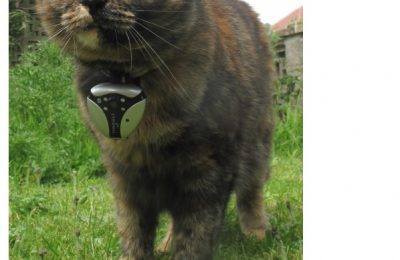If you’ve ever worked in a shelter or veterinary setting, there’s a pretty good chance that you’ve spent some time scruffing cats. Maybe you’ve taken your cat to the vet and the veterinary staff placed your cat in a “scruff-hold.” For those of you who have no idea what I’m talking about, scruffing is a way of restraining cats, by holding them firmly by the loose skin at the back of the neck. For some cats, this type of handling restricts their movement, which can facilitate handling and various procedures like getting a blood sample. Although scruffing is still a common way to handle cats in veterinary clinics, there is increasing resistance to using this type of handling.
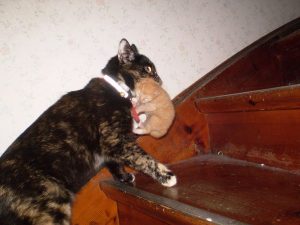
Scruffing likely came into fashion because it resembles the way that mother cats handle their kittens – carrying them by the back of their neck. When the momcat does this, kittens are immobilized and likely easier for mom to relocate. Immobility in other species (such as rabbits and rodents) when scruffed is attributed to anti-predator behavior. Scruffing adult cats can have similar effects (induced immobility), although not in all cats. Because the lack of movement experienced by cats during scruffing may be due to fear, rather than a relaxed state, many individuals and organizations are calling for veterinary staff to embrace other handling techniques for cats.
International Cat Care and the American Association of Feline Practitioners have released statements that scruffing should either not be performed, or should not be the routine, “default” method of handling cats who visit a vet clinic. Other organizations, such as the ASPCA, emphasize other methods of cat restraint. Various certifications are now available for training in low-stress handling, fear-free veterinary practice, and cat-friendly practices.
Now this is all well and good, but as can happen, sometimes people endorse a practice without a strong evidence base. Until the past few months, there have been few published studies related to cat restraint, and whether or not certain handling methods are truly stressful to cats. Dr. Carly Moody devoted her dissertation research to the exploration of various aspects of cat restraint. I blogged about two of her other studies recently, and now she’s got a new paper, hot off the presses, looking at three types of cat restraint. In “Getting a grip: cats respond negatively to scruffing and clips” published in Veterinary Record, scruffing, clipping, and full-body restraint were compared with passive restraint to see whether they led to stress responses in cats.
Fifty-two shelter cats were tested; all cats experienced passive restraint as a control and ONE of the other forms of restraint. Some cats were held with passive restraint first, and others received the experimental condition first, to control for any order effects of being handled. Cats were first assessed as either friendly or unfriendly (I’d prefer a term like avoidant!) by measuring their approach and response to a stranger and being petted, before the restraint methods were tested.
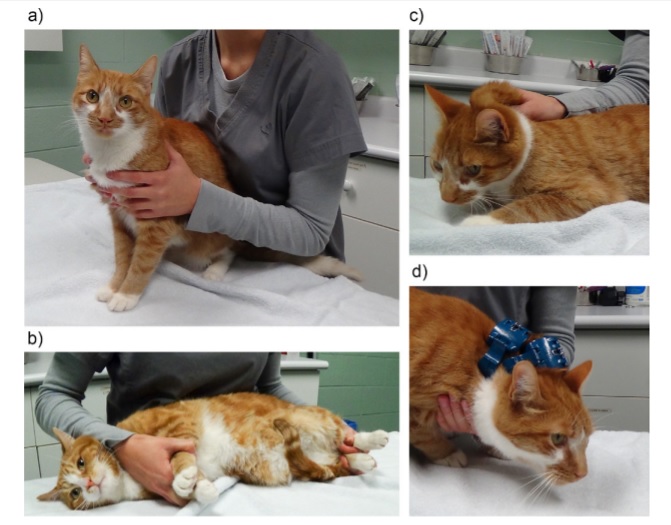
In passive restraint (a), cats were handled with minimal pressure and were allowed to stay in the position they preferred. Full-body restraint (b) involved holding the cat on its side, while holding the legs and not allowing much movement. In the scruff condition (c), cats were held by the skin at the back of the neck and was allowed only minimal movement. Finally, in the clip conditionm(d), two Clipnosis clips were applied to the back of the cat’s neck. Clipnosis clips resemble binder clips, and are a way to scruff “hands-free.” All cats were restrained by the same person in the animal shelter’s clinic facility.
The stress measures included ear movement, respiration rate, pupil dilation, lip licking and vocalizations. The results showed that cats undergoing full-body restraint had a higher respiration rate and more vocalizations. Full-body restraint and clips led to more pupil dilation, and all three tested restraint methods led to more ear movements when compared with passive restraint. To summarize, full-body restraint and clips were the most stressful, and scruffing also led to more stress responses when compared to passive restraint. Three indicators of stress (respiration rate, pupil dilation, and ear movements) were consistent with the previous work from this lab. Based on this study, the authors recommend that people do not use full-body or clip restraint, and that scruffing should not be a default method of handling cats.
A few potential weaknesses of the study include the fact that they did not do any medical procedures on the cats to see if there was any relationship between the type of restraint and cat’s behavior during an exam. The full-body restraint involved laying the cats on their side, which was different from the other three conditions, where the cat was typically upright. It is difficult to say whether it was the restraint or the body position that might have led to the stress response.
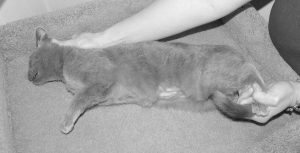
Finally, MY personal experience, is that most handlers who scruff cats, simultaneously place them on their sides in some type of full-body restraint. So it is possible that some people will think that because scruffing was not as stressful as the other tested modes of restraint, that it’s perfectly fine to utilize this form of handling with nary a second thought. It would be great to include this type of handling (scruff + restraining the body) in a future study – it is possible that combining the two techniques is even more stressful than just using one alone.
Scruffing doesn’t prevent biting; many veterinarians have been bitten by cats in practice, and since most clinics (perhaps until recently) likely use scruffing to restrain cats, it is obviously therefore not a guarantee of safety. However, it is a habit that many may find hard to break, especially if they are used to and comfortable scruffing, and not as experienced or comfortable using other methods, such as towel-wrapping or chemical restraint (drugs). Many years ago, when I worked in an animal shelter and handling a lot of cats, I was doing a lot of scruffing! That was the norm. In my current work situation, I’m not routinely restraining cats anymore. But if I were back in that position, I’d be ready to try something different.
At the School of Veterinary Medicine at UC Davis, we teach a cat handling lab to first year students, and the mantra is “EBY – Even Better Yet” – what can we do better to handle animals safely, and in a manner that is likely to reduce stressful responses in the present and during future veterinary visits. These students have typically been trained to scruff cats by default. Sometimes they express resistance to trying something new; but hopefully with practice and increasing evidence that scruffing increases stress, they will get more comfortable with other, less-stressful techniques.
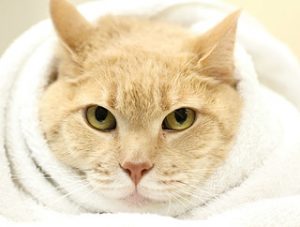
I was recently inspired when my friend Ellen Carozza, LVT told me that her veterinary practice has been “scruff-free” for almost 20 years. And she still has all of her fingers! She has been a strong advocate for providing cats with a safe and low-stress experience at the vet clinic, and has excellent videos of how the staff at her clinic handle “difficult” or “aggressive” cats, including several types of towel wraps. It’s hard to argue with 20 years of proof that it’s not necessary for effective treatment of cats (when we tell the first year vet students that there are scruff-free cat clinics, it blows their minds!). But think of it this way – if aversive restraint techniques were just not allowed or available to you – what would you do instead? And now it’s hard to argue with the mounting scientific evidence that when it comes to handling cats, “less is more.”
Reference

